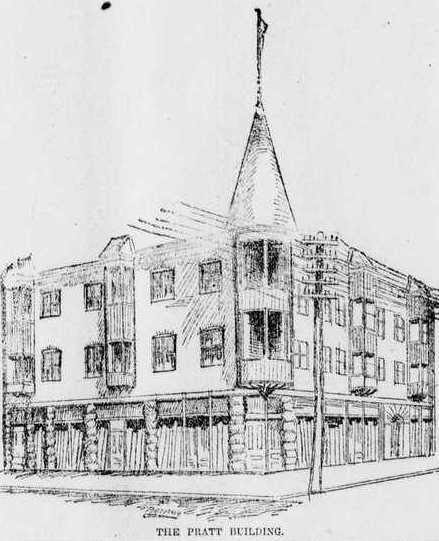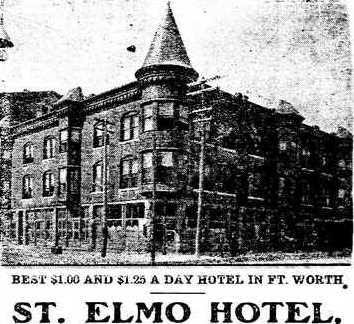Miss Minnie Williams was an attractive young Fort Worth lady attending finishing school in Boston, where she met Mr. Henry Gordon, a successful Chicago business man.
After her graduation, she moved to Denver to live with her elder brother, but wrote Mr. Gordon often.
Minnie was in love.
In 1893 she agreed to be his wife and spent the rest of her life in the Windy City.

Minnie had inherited quite of bit of Fort Worth property, and not long after her marriage, four choice lots in Block 41 were sold to Alexander Bond. On that plot a large rooming house was soon being constructed under the supervision of Mr. O. C. Pratt.
Pratt was industrious. When not busy at the building site he found other uses for his time.
He bought carloads of bicycles, china, and furniture, all on credit, and sold them quickly for less than was owed for them. This was extremely profitable because Pratt never intended to pay the manufacturers and wholesalers.
His final act of larceny in Fort Worth was the purchase of horses using forged bank notes. History has shown stealing horses in Texas to be an unwise career move.
Pratt was on the run.
And so was Alexander Bond.
And so was Mr. Henry Gordon of Chicago, for they were all the same man.
He was best known as Dr. H. H. Holmes, but that was not his true identity either.
His real name was Herman Mudgett and he was a monster.

The rest of Minnie’s life after her marriage was indeed spent in Chicago, but it was counted in months, not years. Before removing to Fort Worth, Mudgett had poisoned Minnie and buried her in the basement of the hotel he owned on 63rd Street in the Chicago suburb of Englewood.
Mudgett was moving his base of operations to Texas and the structure being built in Fort Worth was meant to take the place of the Englewood building and serve all the same functions.
Those functions were grisly.
The upper two floors of Holmes Castle, as locals called it, were a maze of a hundred windowless rooms and dead-end corridors.
Some were air tight and fitted with gas jets that could be operated remotely. After the scope of Mudgett’s deeds became known it was called by another name: The Murder Castle.

Some estimate that Mudgett killed as many as 200 people over a period of four years. Most were Midwestern girls who had gone to the big city alone to find work.
Mudgett hired them to work in shops on the ground level of his hotel building, and generously offered to let them stay in one of those windowless rooms with the remotely controlled gas jets. He had beaten the Nazis to this solution by half a century.

Their bodies were then dropped down a greased chute to the basement. Some were fleshed and the skeletons articulated with brass wire to be sold to medical schools. Others were cremated in a special kiln of Mudgett’s own design.
If not for his decision to steal horses, the same might have happened in Fort Worth. Instead Mudgett fled for the East Coast.
When Pinkerton detectives caught up with him, he was relieved to learn they were holding him for his many insurance scams instead of the horse theft warrant from Texas.
He told them, “I dislike fearfully to go to Fort Worth to serve a term. I would rather be here in Philadelphia five years than one in Fort Worth.”
Meanwhile, Chicago authorities where discovering all the horrors the Murder Castle held: skeletons, a bloody dissection table, piles of women’s clothing, a giant ball of hair wrapped in a blanket.
Mudgett went to the gallows on May 7, 1896. The drop failed to snap his neck and he strangled to death. Slowly.
Perhaps he would have preferred Fort Worth after all.

Categories: Texas Biographies, Texas history

I think there has been MUCH exaggeration in this case. The Chicago building was probably constructed similarly to the Fort Worth one, with basically only a gassing chamber to kill the victims. IF he was selling the bodies and bones to medical schools for dissection and exhibition purposes he would not want to damage them with gory violence; which would look suspicious anyway. It also was used like the Fort Worth building NOT as a “hotel” for guests but as tenements for renting residents. Thus its two upper floor plans would have to reflect the design of that function, as did the Fort Worth. The level the atrocities were committed on was the ramshackle wooden-looking superstructure that does not mesh well with the rest of the building and appears to have been roughly made of lumber, probably for AMPLE VENTILATION given his practices.
Read the book by Eric Larson. The Devil in the White City.